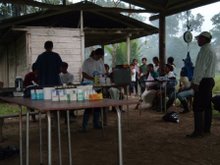Friday, October 19, 2012
Life and Death Decisions
It’s 4:45 am on a Monday. I wake up five minutes before my alarm, as usual. Since residency began, I have never overslept it. I lie still for another five minutes, checking the clock in between to assure my mind that I have a few minutes of luxury left. And then I surrender my bed to the inevitable day.
I arrive to the ICU, bracing myself for the day’s admissions. There is a Whipple, a thoracotomy, and a craniectomy on the OR schedule. They will all come to the SICU after surgery. Since it's Monday, there will also almost certainly be at least one emergent admission from the floor, perhaps a gastrectomy with CHF whose fluid status was mismanaged or neglected over the weekend.
I get a quick signout from night float on last night’s events. I meet the new trauma patients: a drunk head bleed from a pistol whipping, a gunshot to the abdomen with a liver lac and a bowel injury. They are both totally stable, and I plan to move them out as soon as possible. After seeing all the patients, I check all their boxes—make sure their electrolytes are balanced, sugars are controlled, and fluid status is appropriate. I lower their ventilatory support to work their respiratory muscles and make a mental list of who can be extubated.
I round with my attending, trying to keep my presentations crisp. We discuss a sea of numbers, CT scans and xrays. Satisfied that every patient has a plan to advance their care, I turn my attention to the only really sick patient in the unit. Everyone in the unit is sick, of course, but Mrs. Riley is DNR after the family meeting over the weekend, and there is nothing to do for Mr. Ellis after his catastrophic intraparenchymal hemorrhage but schedule a tracheostomy and PEG. Mr. Turner, however, is actively dying—he has a chance, but his window is closing.
I first met Mr Turner a week ago, after a routine sigmoid colectomy. He had suffered repeated episodes of bleeding per rectum and after a colonoscopy tattooed an oozing mass, was offered a partial colectomy to remove the offending lesion. The surgery was uncomplicated, but because of his COPD, recent heart attack and renal failure, the patient was admitted to the ICU for postoperative resuscitation. He was moved to the general floor after two days to make room in the unit. He was almost ready for discharge until his nurse found him collapsed on the bathroom floor in a small pool of dark blood. He was confused, combative, and diaphoretic. The overnight team pumped him with fluids and blood, intubated him, took him to the operating room to remove the bleeding colon, and brought him to the ICU. He had a rising lactate, a pH incompatible with bodily protein function, and multiorgan dysfunction. He was actively dying.
I’m only in my second year of surgical residency, but I can already see where this is going. I put him on a bicarbonate drip to counteract his body’s acidity. I’d like to use a different drug but we are “out of stock” of the proton scavenger that works better than bicarb. He is difficult to ventilate, with oxygen levels barely compatible with life despite maximizing his ventilator settings, putting him at high risk for barotrauma. I’m working his lungs hard, trying to blow off carbon dioxide to reduce his acidity, but I’m running into myself because the bicarb I’m using for the same reason creates more CO2 to blow off. It starts to look futile. I try him on bilevel, thinking he’s in ARDS, but he is already on CRRT because his kidneys shut down and his potassium shot up—his T waves on the monitor are like tall spikes. The bilevel causes his pressure to drop more, because the extra pressure in his lungs prevents the vena cava from filling. Again, running into myself. I add another pressor. We are maxed on three. Options are running out. He has no gag or corneal reflex. I call his wife and have a candid discussion. She says she's on her way.
His belly continues to blow up, with all the fluids we’ve pumped into him. It’s tight as a drum, so we check an abdominal pressure. 30: intraabdominal hypertension. Another reason for hypotension and difficult ventilation. The only option becomes surgery—his abdomen needs to be cut open to relieve the pressure. We rush him to the operating room and cut him stem to sternum. We examine his bowels and organs. Everything looks dusky but there is no evidence of bleeding, necrosis or infection. I almost hope there is something catastrophic to explain his dire clinical status, something to fix so we don’t return to the hopeless 3-pressor, hypoxemic, acidotic state of the morning. We place a plastic bag over the belly and attach it to a specialized vacuum to maintain sterility and drain extra fluid, We now know how this will end.
Wheeling him back to the ICU, I pass several family members gathered outside the ICU door. There are at least fifteen people in the waiting room. A tearful young woman, an elderly lady in a wheelchair. Probably his sister and mother. I get Mr. Turner settled and return to the family, gathering them into the family meeting room. I stare directly at his wife and inform her that her husband is dying, his organs are shutting down, and there's very little chance he will survive for more than 24 hours. This is not the first time I have had this discussion but my mind cringes, expecting a horrific reaction to such unspeakable news. My professional stare does not waver as I move on to discuss options, including withdrawal of care. We offer them time to think, but they don’t need it—-they want everything done. They want him to fight, and they want us to fight for him. We tell them there are limits, that we are out of options, that we are prolonging his suffering. This seems to pain them, but it does not change their minds.
They hover by his door as we discuss how to proceed. There is no sense adding another pressor, as there are only so many receptors in the body to constrict to increase blood pressure. We get a bedside echocardiogram to see if we can improve his heart function, but unfortunately his heart function is adequate. We draw labs to see if his hemoglobin is low—maybe we can give him blood—but his blood levels are sufficient from all the products he has already received. My attending goes home and tells me to call the on-call surgeon for future updates on Mr. Turner—he knows this is a futile case.
The patient hangs on for several hours. Late in the evening, his pressure continues to dip, and then his heart rate. I have no choice but to code him. We drop the bed down and press on his chest. Abdominal fluid seeps through the plastic bag covering his organs—the vacuum seal has been violated. We give boluses of epinephrine, atropine, bicarbonate, calcium and magnesium. We do three rounds because the family refuses to leave his room. If they were not present, we would do less. I call time of death. We clean the patient and finally allow the family to attend to him. I text my attending that he has passed, and receive no answer.
The rest of the night passes uneventfully. Mrs. Riley dies peacefully in the early hours of the next morning, with her four children at bedside, on a dilaudid drip.
Subscribe to:
Posts (Atom)




